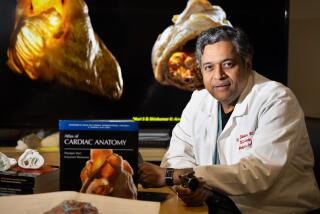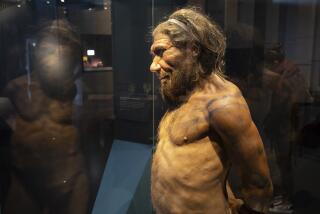Our primitive selves
THE study of anatomy is messy -- blood, bodily fluids, internal organs and assorted other gruesomeness. As someone who can barely make it through an episode of “House” without clamping my eyes shut, I would not have lasted long as a medical student; once that inaugural cadaver was unveiled, I would have been out the door before the first fainter hit the deck. Which is why I am envious of the students at the University of Chicago’s medical school, because if I had had Neil Shubin as my anatomy teacher, as they do, I might have gotten over my squeamishness. Fortunately, Shubin has provided the next best thing. “Your Inner Fish: A Journey Into the 3.5-Billion-Year History of the Human Body” is a delightful introduction to our skeletal structure, viscera and other vital parts -- and evidence that learning the secrets of the human body need not unhinge you.
Shubin is not an M.D. but a paleontologist, who spends his summers north of the Arctic Circle, looking for fossils in layers of stone and sediment. His major discovery is the fossil of a 375-million-year-old amphibious creature -- a key evolutionary link between fish and land dwellers -- that he and his colleagues named Tiktaalik, an Inuit word meaning “large freshwater fish.”
Assigned, because of faculty departures, to teach the human anatomy course at Chicago, Shubin soon realized that the “best road maps to human bodies lie in the bodies of other animals.” Thanks to developments in genome research, molecular biology and good old-fashioned fossil-hunting, we now know that much of the mechanism for making the human body is present in some of the earliest of Earth’s multicellular creatures and in many animals still extant, most of whom dwell in the sea. As Shubin puts it, “the bodies of these creatures are often simpler versions of ours.” He is a warm and disarming guide; he speaks graciously of his colleagues and shares his failures with us. When he tells the thrilling story of coming upon the fossil remains of Tiktaalik in the Arctic wilderness, where anything that might be mistaken for a polar bear (including at one point, embarrassingly, a bunny) sends him scurrying, we share his sense of triumph.
That discovery was also a triumph for evolutionary theory, which predicted that sometime in the late Devonian period an intermediary species between sea creatures and land dwellers had to have emerged. Shubin and his colleagues pinpointed the most likely area where rocks from that epoch would be exposed and spent several summers looking for fossil amphibians. Tiktaalik’s discovery is a strong refutation of the claim that evolution as a theory lacks predictive power.
Tiktaalik is a lesson in human development too. Within its fins are bones that allow it to prop itself up -- these are the ancestors of the bones in the human arm. Tiktaalik is also the first creature whose head can move independently of the rest of its body -- which is to say, it’s the first creature with a neck. Many other features of the human skeleton “can be traced back to a fish like this,” Shubin writes. “This fossil is just as much a part of our history as the African hominids, such as Australopithecus afarensis, the famous ‘Lucy.’ ”
So zoos, and especially aquariums, hold the key to understanding our anatomy; even in existing species, we can trace our evolutionary lineage. To start at the bottom, the lowly and primitive sponge shares important properties with humans. It has different kinds of cells, which perform different functions in what Shubin calls a “division of labor”: “[T]he cells can communicate with one another; and the array of cells functions as a single individual. . . . Most significantly, the sponge has much of the cell adhesion, communication, and scaffolding apparatus that we have. Sponges are bodies, albeit very primitive and relatively disorganized ones.” Multicellularity is an important advance in biology, because single-cell organisms lack the “molecular machinery for cell adhesion, interaction, and so on.” The first multicellular organisms, such as sponges, carried with them the blueprints for the far more complex bodies that followed. The next major evolutionary step on the way to bodies was the body plan -- a design distinguishing front from back, top from bottom. Sea anemones have an incipient form of this bilateralism: They have versions of the genes that direct this kind of development. Next comes the skull, which evolved from an early form of teeth. The first creatures to have teeth were soft-bodied. The first to have some kind of skull -- the ostracoderms, from about 500 million years ago -- had a bony head plate “made up of thousands of small teeth fused together.” Shubin’s conclusion: “Hard bones arose not to protect animals, but to eat them.”
Those head bones were to evolve in all sorts of interesting ways. Some of the jawbones of fish and reptiles became, in humans, the bones within our ears that allow us to process sound across a range of frequencies. This repurposing has its downside, however. Nerves that extend from facial muscles to our brain take complicated paths -- paths that reflect primitive skeletal placement. Nor is this problematic kind of configuration confined to the human head. The nerves that control the diaphragm exit the brain stem, near the neck; “a rational design,” Shubin explains, “would have the nerves traveling not from the neck but from nearer the diaphragm.” However, “the brain stem originally controlled breathing in fish” -- in which the placement was a great deal more efficient. “We can dress up a fish only so much without paying a price,” Shubin writes. We choke, succumb to hiccups, develop hemorrhoids and hernias and fall prey to heart disease all because our bodies are spruced-up versions of primitive models, and the kludges and patches that have developed over millions of years of evolution, like all kludges and patches, inevitably break down.
Knowledge of the human body’s primitive origins, Shubin argues, leads to new pathways in treating disease, but the one example he offers, a rare mitochondrial-borne illness far removed from the book’s anatomical theme, isn’t enough to convince. Yet he may be right. Future researchers, aware that the ingredients of our evolutionary precursors are part of the human recipe, may well find new ways to prevent the wear and tear on our fish-begotten bodies. And who knows? Maybe one or two of them will have had their first taste of the marvels of human evolution in Neil Shubin’s anatomy class.






